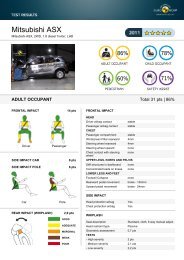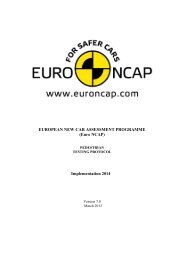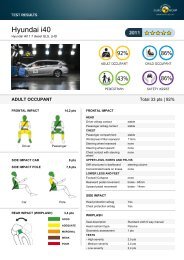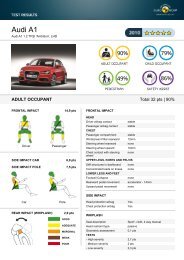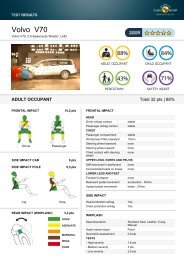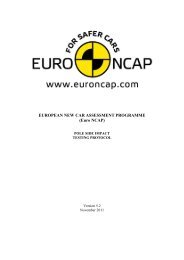Whiplash Testing Protocol - Euro NCAP
Whiplash Testing Protocol - Euro NCAP
Whiplash Testing Protocol - Euro NCAP
You also want an ePaper? Increase the reach of your titles
YUMPU automatically turns print PDFs into web optimized ePapers that Google loves.
Version 3.1<br />
June 2011<br />
Probe displacement = scale reading<br />
Figure 9: Head restraint probe backset for static geometry<br />
6.4 Measure and record reference geometry for BioRID setup<br />
The HRMD probe measurements used for the geometric assessment will be different than the<br />
geometry recorded for use during the BioRID setup. This is due to the curvature of the HRMD<br />
probes and is illustrated in Figure 10.<br />
Since the BioRID is set up based on reference geometry recorded using the HRMD, there is a need to<br />
measure an equivalent feature on both devices. The rear most point on the HRMD skull (i.e. the<br />
screw on the backset probe) is equivalent to the rearmost point on the centreline of the dummy‟s<br />
skullcap. This point can be found using a measuring tape that contours to the shape of the skullcap:<br />
the point is 95mm from the top of the skullcap along the mid sagittal plane of the skull.<br />
6.4.1 Mark an identifiable point on the head restraint along its vertical centreline. A suggested<br />
point is defined by first contact point between backset probe and head restraint.<br />
6.4.2 Ensure that the backset probe is installed and pushed flush against the HRMD, i.e.<br />
stowed/retracted.<br />
6.4.3 Locate the screw on the centre of the rear surface of the HRMD backset probe.<br />
6.4.4 Measure and record the BioRID reference backset using CMM (as defined in Section 2.3.3).<br />
This is the horizontal distance between the rearmost point on the HRMD skull (i.e. the screw<br />
on the retracted backset probe) and the identifiable point on the head restraint +15mm, see<br />
Figure 10.<br />
6.4.5 Ensure that the head restraint has been marked such that it can reliably be returned to the test<br />
position. Move the head restraint to the lowest position as defined in Section 6.1.1. Whilst<br />
maintaining that lowest position, move the head restraint to the most rearward tilt possible as<br />
defined by Section 6.1.3 and 6.2.3.2.4. Measure the HRMD backset and height to the nearest<br />
millimetre using the probes.<br />
22



